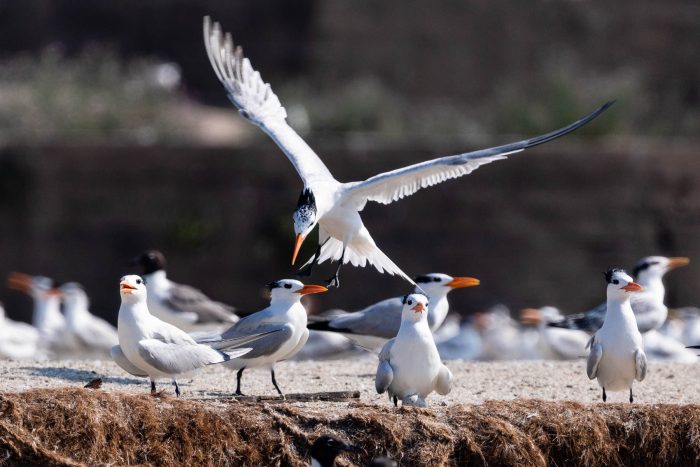Royal Tern
Thalasseus maximus
The royal tern is a large seabird with a thick orange bill that can be found along Chesapeake coastal beaches during its breeding season.
This section shows one large critter image at a time. Use the thumbnails that follow to select a specific image to display here.

This gallery contains a grid of small thumbnails. Selecting a thumbnail will change the main image in the preceding section.
Appearance
The royal tern is large with an orange bill and a forked tail. It averages between 18 and 20 inches in length and has a wingspan of 39 to 53 inches. Royal terns are mostly white, with a pale gray back and upper wings. They have a black mask that extends around the back of their heads to form a spiky crest behind their heads. Some royal terns might have a completely black cap, but only during the breeding season.
Males and females look alike, and while juveniles look similar to adults, they are smaller and pale yellow. They have darker wingtips and dark spots on their backs. It takes them three years to get their full adult plumage.
Feeding
Royal terns eat small fish, shrimp and crustaceans. They catch them by flying over the water with the bills pointed down and then plunge into the water.
Flight
Flight pattern is a direct flight with deep, steady wing beats.
Voice
Their call is a loud, rolling keer-reet. They sound like a Caspian Tern, but higher pitched.
Reproduction and life cycle
The breeding season begins in May. Courtship involves high spiraling flights by two or more birds. Royal terns are ground breeders and dig out nests in the soil or sand. They nest in colonies, ranging from 100 to 4,000 breeding pairs.
Royal terns generally have only one egg, but sometimes two. Young terns leave the nest within a day after hatching. All young chicks come together in a group known as a creche, which can have thousands of terns that range in age from two to 35 days old. Despite this large group, a pair of terns will only feed their own young. They are likely able to find it in the creche by recognizing its call. First flight occurs at about four or five weeks, and young remain with parents for up to eight months. Royal terns usually breed starting at the age of four.
Did you know?
- The royal tern is the second-largest tern. The largest is the Caspian tern.
- A group of royal terns is known as a “highness.”
- Royal tern populations seriously declined in the late 1800s and early 1900s when eggs were used as food. Their populations have since made a substantial comeback in the 20th century.
- The oldest royal tern was over 30 years old. Found in Belize in 2013, it had been banded in North Carolina in 1983.
Sources and additional information
- Life in the Chesapeake Bay by Alice Jane Lippson and Robert L. Lippson
- Royal Tern – Patuxent Wildlife Research Center
- All About Birds: Royal Tern – The Cornell Lab of Ornithology
- Guide to North American Birds: Royal Tern – Audubon
- Beauty of Birds: Royal Tern – AvianWeb
